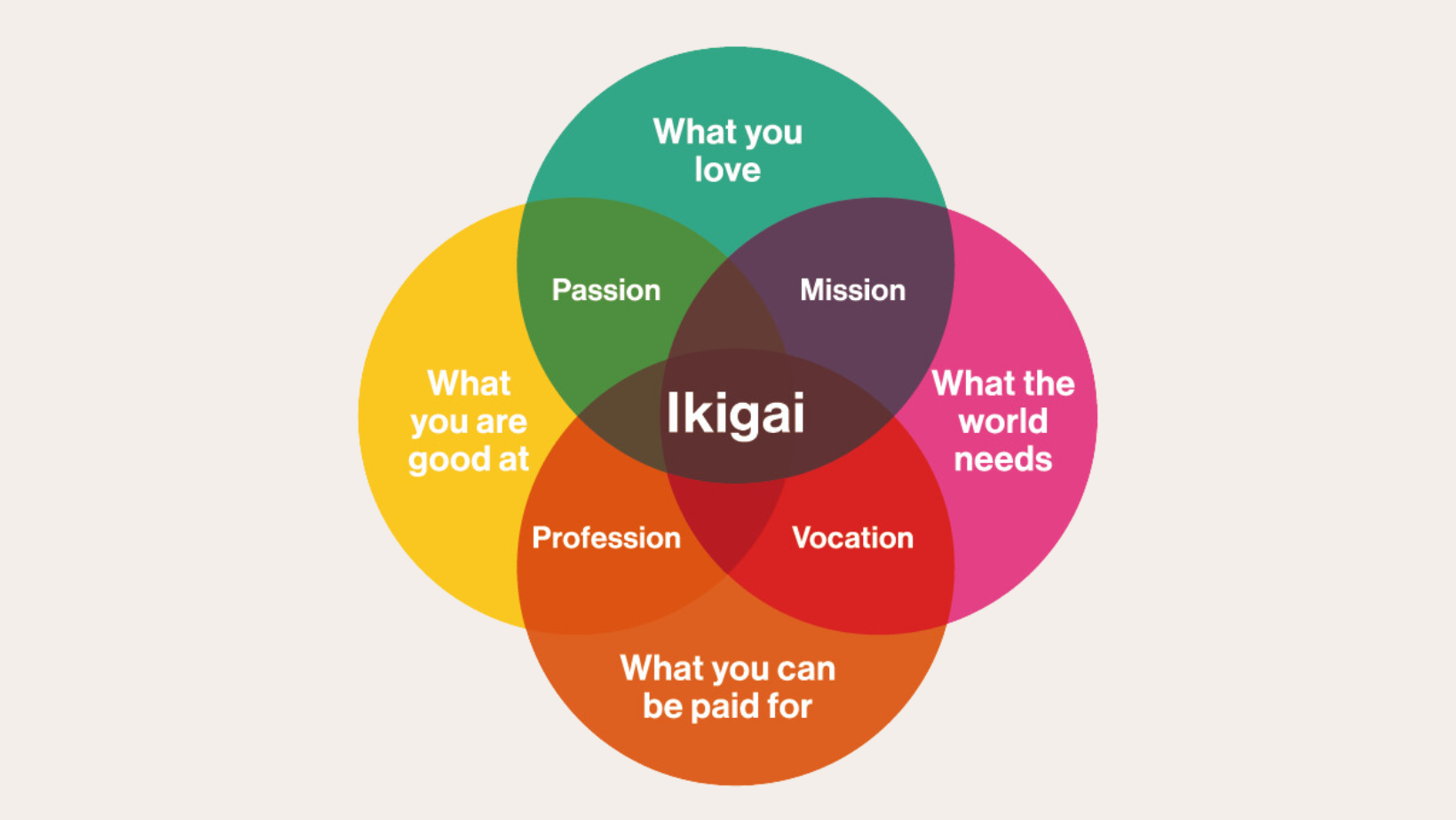
In this article, we explore the power of an ancient Japanese philosophy - Ikigai - and how it can enhance the growth and impact of your practice. Whether you're a seasoned Shiatsu practitioner or just starting out, implementing Ikigai principles could guide you towards building a successful and meaningful business.
In the pursuit of building a successful business, finding purpose and fulfillment is essential. One framework that can help Practitioners align their passion, skills, customer needs, and financial viability is the Ikigai framework.
Originating from Japan, Ikigai represents the intersection of four key elements that can guide individuals towards a fulfilling business vision. The term "ikigai" combines the Japanese words "iki," which means life, and "gai," which means value or worth. It represents the intersection of four key elements: what you love, what you are good at, what the world needs, and what you can be rewarded for. The framework is often depicted as a Venn diagram with four overlapping circles.
The sweet spot at the centre of these four elements represents your ikigai—the intersection where all these aspects converge. It represents a balance between what you love, what you are good at, what the world needs, and what you can be rewarded for.
It is believed that by discovering and pursuing your ikigai, you can experience a sense of purpose, fulfillment, and satisfaction in your personal and professional life.
In this article, we will explore how the Ikigai framework can be applied to refine your business ideas and create a vision that resonates with your target client base.
Framework Steps

Discover What You Love
The first step in applying the Ikigai framework is identifying what you truly love within your business. Consider the aspects that bring you joy and fulfillment. Is it the core service you provide or the positive impact you make on your clients lives? By pinpointing what you love, you can infuse your passion into every aspect of your business.
- Example: XYZ has a genuine love for providing Shiatsu treatments that promote relaxation and holistic wellness for women.

What Are You Good At? Assess Your Skills and Expertise:
This aspect focuses on your skills, talents, and areas of expertise. It involves understanding your strengths and abilities, the things you excel at or have the potential to develop proficiency in. Assess what sets you apart from others in your field. Identify the skills you have developed and any unique qualities or approaches you bring. This self-assessment will help you leverage your strengths and stand out in a competitive market.
- Consider using self-reflection & feedback. Conduct a SWOT Analysis: Assess your strengths, weaknesses, opportunities, and threats related to your business. This exercise can help you gain a better understanding of your skills and areas for improvement.
- Seek feedback from peers, mentors, or clients: Request input from those who have worked closely with you. They can provide valuable insights into your strengths and areas where you excel.
- Remember, these tools are meant to assist you in assessing and understanding your skills and expertise. They should be used in conjunction with self-reflection and real-world experience to gain a comprehensive understanding of your strengths.
- Example: XYZ has honed her skills in various Shiatsu techniques and possesses a deep understanding of the specific needs and preferences of women seeking complementary therapies.

What Does The World Need? Address Customer Needs:
This element involves identifying the needs, problems, or challenges that exist in the world or within a particular community. It requires considering how you can contribute to making a positive impact or addressing those needs.
To create a successful business, it is vital to address the needs and desires of your target client base. Analyse the challenges they face, their specific health concerns, and what they are seeking in terms of wellness. By aligning your services with their needs, you can build a loyal customer base.
Google can be a valuable tool for understanding your target audience's concerns. Here are a few strategies you can employ:
- Keyword Research: Utilise Google's keyword research tools, such as Google Keyword Planner or Google Trends, to identify popular search terms and topics related to Shiatsu/health and wellbeing. By analysing the keywords your target audience is searching for, you can gain insights into their concerns and interests.
- Search Engine Suggestions: When you start typing a query in Google's search bar, you'll notice that Google provides suggestions based on popular searches. These suggestions can give you an idea of what people are commonly searching for, indicating their concerns and questions.
- Online Forums and Communities: Search for relevant forums, discussion boards, and social media groups where your target audience engages in conversations. Explore the topics being discussed, questions being asked, and the challenges they are facing. This can provide valuable insights into their concerns and needs.
- Social Media Listening: Monitor social media platforms like Facebook, Twitter, and Instagram to understand what your target audience is discussing, sharing, and commenting on. Pay attention to relevant hashtags, comments, and discussions related to health, wellbeing, and complementary therapies. This can help you identify their concerns and topics of interest.
- Competitor Analysis: Research your competitors and analyse their websites, blog posts, social media presence, and customer reviews. Look for patterns and recurring themes in terms of the concerns and feedback shared by their customers. This can provide insights into the broader concerns within your target client base.
Remember, while Google can provide valuable information, it's important to complement your research with other sources, such as surveys, interviews, and direct interactions with your target client base. Building a deeper understanding of your client’s concerns and needs will allow you to tailor your offerings and messaging more effectively.
- Example: XYZ Therapies recognises that many women seek natural and holistic approaches to improve their health and overall wellbeing. They offer personalized and rejuvenating therapies that provide stress relief, promote relaxation, and enhance physical and mental wellness.

Embrace Financial Viability:
This aspect encompasses the practical and financial aspect of your work. It involves finding opportunities that align with your passions, skills, and the needs of the world, which can provide you with a sense of purpose and financial stability.
While passion and purpose drive your business, financial viability is also crucial for sustainability.
Exploring different revenue streams, pricing models, and opportunities for growth is crucial for the success and sustainability of your business. Here are some strategies to consider:
-
Diversify Your Offerings:
Expand your service range: Consider adding new services or complementary therapies that align with your target audience's needs and interests. For example, you could introduce additional wellness treatments, workshops, or educational programs.
Offer packages and memberships: Create bundled packages or membership options that provide added value and encourage customer loyalty. -
Target New Markets:
Identify niche markets: Research and identify specific segments within your target audience that have unique needs or preferences. Tailor your offerings to cater to those niches, such as prenatal massages for expectant mothers or specialized therapies for athletes.
Consider corporate partnerships: Explore partnerships with local businesses, corporate wellness programs, or event organisers to provide your services to their employees or attendees. -
Online Presence and E-commerce:
Develop an online store: If feasible, create an e-commerce platform to sell your gift vouchers or digital resources such as guided self-massage recordings or wellness e-books
Online consultations and classes: Offer virtual consultations or workshops that can be accessed remotely, allowing you to reach a broader audience beyond your local area. -
Collaborations and Partnerships:
Collaborate with other practitioners: Team up with complementary health and wellness professionals to offer joint services or referral programs.
Strategic alliances: Identify non-competing businesses that share a similar target audience and explore cross-promotional opportunities, co-marketing campaigns, or joint events. -
Pricing Strategies:
Value-based pricing: Consider pricing your services based on the unique value and benefits they provide to your customers, rather than solely on cost or competition.
Tiered pricing: Offer different service packages at various price points to accommodate different budgets and needs.
Subscription models: Explore subscription-based pricing for ongoing services, memberships, or exclusive content. -
Market Research and Customer Feedback:
Conduct surveys and interviews: Gather feedback from your existing customers and target audience to understand their preferences, willingness to pay, and suggestions for improvement.
Monitor industry trends: Stay updated on emerging trends, new techniques, and innovative business models within the health and wellness industry to identify potential growth opportunities.
Remember, careful analysis, experimentation, and continuous monitoring of results are essential when exploring new revenue streams, pricing models, and growth opportunities. Regularly assess the performance of different initiatives and be open to adapting and refining your strategies based on customer feedback and market dynamics.
- Example: XYZ Therapies generates revenue through session fees, package offerings, and workshops.
Conclusions
By examining these elements within the Ikigai framework, you can refine your business ideas and vision. Here's how you can consolidate your insights:
- Craft a mission statement that highlights the unique value you bring to your target audience: e.g., "Our mission is to provide rejuvenating Shiatsu treatments tailored to women's specific health and wellbeing needs, promoting relaxation, stress relief, and holistic wellness"
- Identify specific services or treatments that align with the needs and desires of your target audience: e.g. "We offer a range of East Asian therapies designed to enhance physical and mental wellness, including traditional techniques and specialised treatments for stress reduction, rejuvenation, and overall wellbeing"
- Develop a marketing strategy that communicates your passion, expertise, and the benefits of your services to your target audience: e.g. emphasise the holistic approach, personalised care, and the positive impact on women's health and wellbeing through your website content, social media presence, and promotional materials.
Remember, your business vision is a dynamic process that requires continuous refinement and adaptation. Regularly assess your alignment with the Ikigai framework as you gain insights and feedback from your customers. With persistence and dedication, your business can thrive while providing you with a sense of purpose and fulfilment.
Written by Emma Stanley BSc (Hons), MrSS, tESA(p)
In our fast-paced and ever-evolving world, finding a sense of purpose and fulfilment in our professional lives has become increasingly important. This article is a result of my own exploration and reflections on how Ikigai can inform and shape the path of a Shiatsu practitioner. I hope it inspires you to reflect on your own Ikigai and explore how it can enrich your journey as a Shiatsu practitioner
FURTHER READING
If you'd like to explore more on this topic - IKIGAI - The Japanese Secret To a Long And Happy Life by Hector Garcia & Francesc Miralles is a very good read.